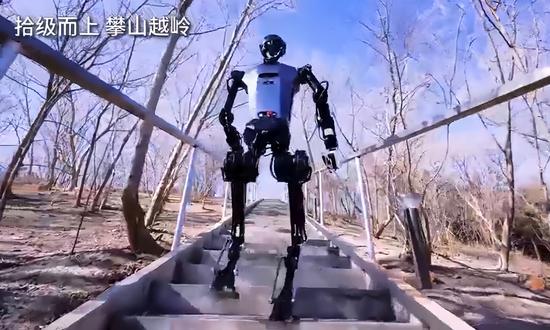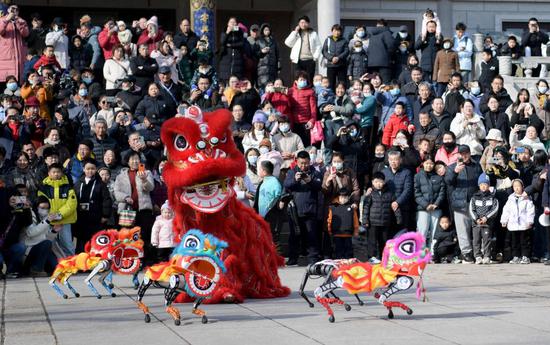
China's "Tien Kung" humanoid robot has achieved a world-first by climbing 134 outdoor stairs, reaching the summit of the Haizi Wall Park in Beijing on February 17, 2025. (Photo/Courtesy of National and Local Co-built Embodied AI Robotics Innovation Center)
China's "Tien Kung" humanoid robot has achieved a world-first by climbing 134 outdoor stairs, reaching the summit of the Haizi Wall Park in Beijing. This marks the first time a humanoid robot has demonstrated such advanced mobility in a complex outdoor environment.
The robot, developed by the National and Local Co-built Embodied AI Robotics Innovation Center, features vision-based walking, enabling it to navigate stairs and 35-centimeter height differences without any missteps or falling. It can run at a maximum speed of 12 kilometers per hour, sprint on snow, and maintain stability under strong impact, showcasing enhanced resilience, according to a statement the innovation center sent to the Global Times on Monday.
"The park's stairs are complex, with uneven heights, and some are damaged or loose, presenting significant challenges even for human climbers, but 'Tien Kung' successfully passed the test," a representative of the innovation center told the Global Times.
Compared with earlier humanoid robots that relied on pre-scanned 3D models and fixed steps to navigate stairs, failing in unpredictable terrains, "Tien Kung" integrates perceptual abilities into its movement algorithms, allowing seamless, collision-free navigation of multi-level stairs, the statement said.
Improving mobility in complex terrains is key for humanoid robots to transition from labs to real-world tasks, paving the way for their large-scale deployment in extreme environments like mountains, snow, and disaster rescue operations, according to the statement.
In the future, this technology will be integrated into the open-source ecosystem developed by the National Innovation Center, paving the way for broader industrial applications, it said.
In recent years, China's robot industry has developed rapidly, with various types of robots gaining influence both domestically and internationally, industrial observers said.
During the Spring Festival Gala of the Year of the Snake on January 28, 16 humanoid robot dancers performed a Yangge folk dance alongside human dancers, captivating audiences on overseas social media. The performance, which blended cultural heritage with cutting-edge technology, showcased an innovative approach that impressed viewers worldwide.
On February 10, a home-grown quadruped robot was put into operation by a local fire and rescue team in Changsha, Central China's Hunan Province. "The robot can operate in environments ranging from minus 20 to 55C without any issues," its developer told the Global Times.
A hiking-assist robot exoskeleton made its trial debut at Mount Tai scenic area in Tai'an, East China's Shandong Province, during the Chinese New Year holiday, offering climbers a groundbreaking way to scale the iconic peak, Xinhua reported.
China has become the world's largest market for robot applications. In recent years, the rapid growth of the country's robotics industry has led to the deployment of robots across various sectors, including warehouse logistics, education and entertainment, cleaning services, security inspection and medical rehabilitation, the Xinhua News Agency reported.
Morgan Stanley recently said that China holds approximately 63 percent of the global supply chain for humanoid robots. Market forecasts predict that by 2050, China's humanoid robot market will reach a scale of 6 trillion yuan ($827.13 billion), with a total of 59 million units, as quoted in a report by 21jingji.com.
According to a guideline released in 2023 by the Ministry of Industry and Information Technology, by 2025, a humanoid robotics innovation system will be in place, with breakthroughs in key technologies, ensuring a stable supply of core components in the country. Robots will meet international standards, enter mass production, and be applied in specialized, manufacturing and public service sectors. By 2027, innovation capabilities will be significantly strengthened, supported by a secure and reliable industrial supply chain with global competitiveness.
"China has emerged as a formidable player in artificial intelligence, and in the field of humanoid robotics, we are catching up with developed countries and striving to leapfrog ahead. With a strong manufacturing base and a complete industrial chain, China can improve quality while reducing costs," Liu Gang, chief economist at the Chinese Institute of New Generation AI Development Strategies, told the Global Times.
Liu noted that China's robotics advantages include strong demand, a powerful manufacturing sector, and a vibrant entrepreneurial ecosystem. As the industry scales, its competitiveness will continue to rise, supported by an improving supply chain and the growth of industrial clusters.


















































 京公網安備 11010202009201號
京公網安備 11010202009201號